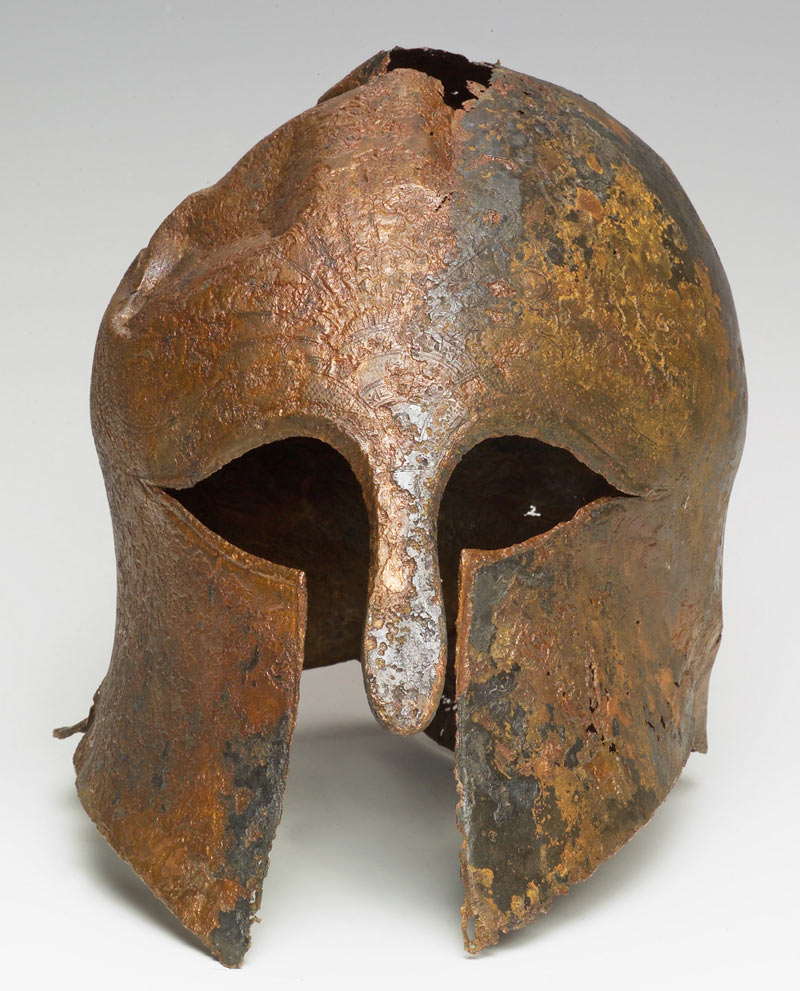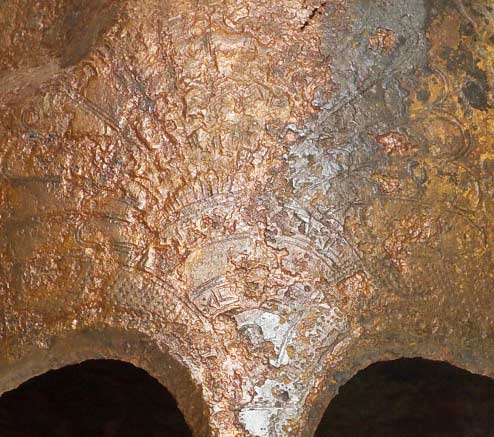Found: Ancient Warrior's Helmet, Owner Unknown

A Greek bronze helmet, covered with gold leaf and decorated with snakes, lions and a peacock's tail (or palmette), has been discovered in the waters of Haifa Bay in Israel. But how this helmet ended up at the bottom of the bay is a mystery.
The helmet dates back around 2,600 years and likely belonged to a wealthy Greek mercenary who took part in a series of wars, immortalized in the Bible, which ravaged the region at that time. Archaeologists believe that he likely fought for an Egyptian pharaoh named Necho II.
Dredging discovery
The helmet was discovered accidentally in 2007 during commercial dredging operations in the harbor. After it was discovered, conservators with the Israel Antiquities Authority went to work cleaning it and archaeologists began to analyze it.
They discovered that it is very similar to another helmet found in the 1950s near the Italian island of Giglio, about 1,500 miles (2,300 kilometers) away. That helmet has been dated to around 2,600 years ago, something which helped the researchers arrive at a date for the Haifa Bay helmet.

"The gilding and figural ornaments make this one of the most ornate pieces of early Greek armor discovered," writes Jacob Sharvit, director of the Marine Archaeology Unit with the Israel Antiquities Authority, and John Hale, a professor at the University of Louisville, in a summary of their research which was presented at a recent meeting.
This Greek warrior likely would have been a very wealthy individual, as few soldiers could afford such an ornate helmet. The researchers aren't sure where the helmet was made, though they suspect the warrior could be from one of the Greek colonies in Ionia, on the west coast of modern-day Turkey. [The History of Human Aggression]
Sign up for the Live Science daily newsletter now
Get the world’s most fascinating discoveries delivered straight to your inbox.
Greek warrior loses helmet
At the time the helmet was made, circa 600 B.C., Greek colonies dotted the Mediterranean coast, stretching from the Black Sea to southern France. Even so, there is no evidence of Greek colonies in Israel, indicating the warrior who ventured into Haifa Bay was likely the leader of a group of Greek mercenaries.
This warrior was likely one of Egyptian pharaoh Necho II's troops, which he sent through Israel accompanied by a fleet of ancient ships. The pharaoh was heavily involved in military campaigns in the region for nearly a decade, operations in which this warrior and his group likely were involved. [Photos: Amazing Egyptian Discoveries]
"They were not fighting for the Greeks, they were fighting for Egypt," Sharvit told LiveScience in an interview.
The series of wars engulfed Egypt, Judah (a Jewish kingdom), Assyria and Babylon, with Necho II of Egypt intervening on the side of Assyria.
The end result of these conflicts was the conquest of Judah and the rise of a resurgent Babylon led by King Nebuchadnezzar II. These events would be immortalized in the Torah (the Christian Old Testament).
At some point, amidst all this history, the elite Greek warrior's helmet ended up at the bottom of Haifa Bay.
Bottom of the harbor
The simplest (albeit most embarrassing) explanation is as to how the helmet ended up at the bottom of Haifa Bay is that somebody dropped it while the warrior's ship was sailing into the harbor.
Another possibility is that the ship carrying the warrior sank, suggesting an ancient shipwreck awaits discovery. "We are planning to go back to the same site and to try to locate other (archaeological) material there," Sharvit said.
Yet another possibility (again, an embarrassing one for the warrior) is that the helmet was lost during a retreat after Necho II's armies were defeated by the Babylonians.
The results of the researchers' work were presented in January at the annual meeting of the Archaeological Institute of America. The helmet itself is now on display at the National Maritime Museum in Haifa.

Owen Jarus is a regular contributor to Live Science who writes about archaeology and humans' past. He has also written for The Independent (UK), The Canadian Press (CP) and The Associated Press (AP), among others. Owen has a bachelor of arts degree from the University of Toronto and a journalism degree from Ryerson University.
'It's answering one of the questions of the century': Scientists may finally know where the oldest gold in the universe came from
Doomed Soviet satellite from 1972 will tumble uncontrollably to Earth next week — and it could land almost anywhere
In rare evolutionary event, weird platypus cousin evolved from living in water to living on land









